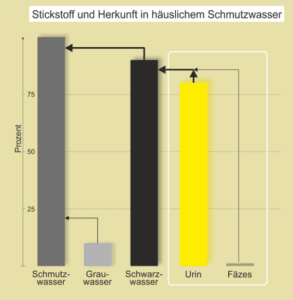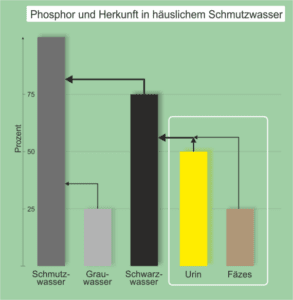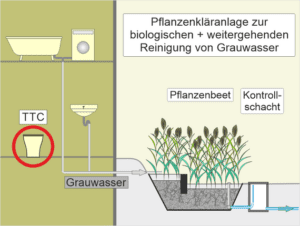Nice to know
On this page we try to bring some general information about our excrement, the different types of toilets and more closer. All stuff that is nice to know.
We at ABEREUS deal with this intimate topic on a daily basis and would like to shed some light on it here.
As a source we use information from DWA, the United Nations and the German Federal Ministry for environment. For some values and data, there are different perspectives and thus also different results or conclusions. Also, topics continue to develop and new findings are added. If you notice something that we are no longer up to date, please let us know.

Waste water
Waste water
According to the Water Resources Act (WHG), wastewater is water whose properties have been altered by domestic, commercial, agricultural or other use, as well as water collected from precipitation running off from built-up or paved areas.
Domestic wastewater is crucial for us and consists of black water and gray water.
Black water
Black water is the discharge water from water flush toilets. It consists of excrement (urine + feces) and the flushing water.
Due to our excrement , this water is often heavily polluted.
Grey water
Gray water is all the remaining wastewater. It comes mainly from the kitchen and bathroom. This includes the water from hand washing and showering as well as the wastewater from the dishwasher or washing machine.
Gray water is not as heavily polluted as black water.
Waste water volume
The amount of wastewater is 90 – 150 liters per inhabitant per day in Germany. This includes 1.2% urine (1.4 l) and 0.1% feces (140 g).
The 1.3% excrement are flushed away in the toilet with 20 times the amount of water. By mixing with the gray water, this quantity increases again significantly up to 300%. This produces the mixture of substances known as dirty water.
Fecal pathogens
Fecal pathogens enter the wastewater almost exclusively via feces and the toilet. These originate from the 0.1 % by volume of feces in the wastewater, since urine is normally germ-free.
Hygienization (4th treatment stage) is carried out in exceptional cases when water is discharged into water bodies with special usage requirements, such as bathing water. A well-known example of this is the Isar River. The hygienic condition of most wastewater treatment plant effluents without 4th treatment stage is insufficient and critical. Corresponding retrofits are already being implemented. These investments will first become noticeable in the treatment costs and later also in the fees of the municipality.
The load of pathogenic fecal germs would be decisively reduced by the separation of the feces.
Pharmaceutical residues and drugs
Pharmaceutical and drug residues enter the wastewater almost exclusively via excrement. Urine in particular is known to many of us for this, keyword: “doping controls in sports”.
The removal of drug residues (4th treatment stage) is carried out in a few exceptional cases. As the costs for this are very high and a complete removal of all drug groups is hardly possible, it will take time. The retrofitting of wastewater treatment plants will lead to increasing treatment costs in the future. So, it will then be reflected in rising wastewater charges.
This impact of pharmaceutical residues and drugs would be decisively reduced by the separation of the fecal matter.
Tenside and microplastics
Tensides and microplastics are found in personal care products as well as in our detergents. These two critical groups of substances are found in gray water, i.e. the water from the kitchen and bathroom.
Excrement
General
Everyone has to go to the toilet several times a day. However, the frequency varies greatly and depends on both the individual and the particular food.
The bladder and urine
On average, each person excretes 1.5 liters of urine and should drink between 2 and 3 liters per day.
Since our bladder starts to “squeeze” at a volume of 0.3 to 0.5 liters, it follows that each of us normally has to go to the toilet 6 to 7 times a day. The bladder of a woman is usually smaller than that of a man.
Those who drink more, of course, also have to pee more often.
The intestine and feces
It’s a little different with the big business. Our intestines are somewhat larger and also more flexible.
It is true that 1x per day should be the optimum, but this does not apply to many. One rule that has become established here is the “3-3 rule”. This states that most people in the world have a stool 3 times a day to 3 times a week.
Here, a person excretes an average of 140 g of feces. With a vegetarian or vegan diet, even up to 400 g of feces are produced.
Reusable materials in wastewater
Recyclable materials in wastewater
Our excrement have not only negative aspects, but also various elements that we can and should reuse. The natural cycle has been interrupted by us humans.
Carbon
Carbon is the organic element. Therefore, of course, it is also present in our excrement and not too little.
More than half of the organic matter enters the wastewater from one thousandth of the total volume – feces.

The removal of organic matter is called full biological treatment (2nd treatment stage). This is sewage treatment plant standard and minimum purification. The organic components are degraded and transformed by microorganisms. The energy-consuming introduction of air into the wastewater is necessary for the oxygen supply of the organisms. In the process, a portion is released into the atmosphere as CO2. The resulting sewage sludge is mainly incinerated in Germany, even after it has been used in a bio gas plant to produce methane. The methane yield is low compared to feces. Incineration often requires transport and thus additional energy.
Since the carbon compounds originate mainly from the feces, it makes sense to use these small amounts (60 l per year) directly for bio gas, compost or biochar production. At the same time, the wastewater treatment effort is reduced considerably.
Nitrogen
About 90% of the nitrogen contained in wastewater comes from black water, of which about 80% is urine.

Nutrient removal (3rd treatment stage) is generally required for large wastewater treatment plants and in the case of discharge into sensitive waters.
Nitrogen removal requires a high energy input in the wastewater treatment plant. Nitrogen is thereby out-gassed from the wastewater into the atmosphere. At another point, we need a lot of energy to extract nitrogen from the atmosphere for nitrogen fertilizer.
These two processes could be combined in some way, and this would save a lot of energy. The nitrogen could be extracted directly from urine. For this, it would be good if the urine were available as a single substance stream.
Phosphorus
About 75% of the phosphorus enters the wastewater from the feces. Of this, 50% comes from urine and 25% from feces.

Nutrient removal (3rd stage treatment) is required for large wastewater treatment plants and when discharging into sensitive waters.
Phosphorus is available in its easily usable form in limited quantities. It is an essential nutrient, because without phosphorus there is no growth of plants, animals or humans. Degradable phosphate deposits are running out worldwide. Recovery from our excrement is therefore important and will be demanded by the EU in the future.
Especially waters are sensitive to phosphorus, because this nutrient is mostly present there in limiting amounts – the growth of algae is thus limited. Small amounts increase algae growth and eutrophication. Thus, urinating into a clear lake can endanger it.
Types of toilets
General
There are very different types of toilets. Different solutions to make our excrement disappear have been implemented for thousands of years.
By the way, the first water toilets were used more than 4,000 years ago, so not such a modern invention.
Chemical toilets
Most of us know Dixi or ToiToi. Of course, there are other manufacturers as well. These toilets use a chemical mixture with water to eliminate our excrement odor and stop all biological processes. Our excrement are also disinfected in this way. In this way, the substances can be stored for a while.
Litter toilets
Various toilets use a so-called litter. This is mainly to bind the smell and moisture of our excrement. In addition, this litter can obscure the view of the previous person’s feces.
Litter often consists of chips or other natural substances. The substances can become very solid over time due to the removal of humidity.
Compost toilets
A composting toilet attempts to compost the excrement directly in the toilet or facility. In order to maintain odor neutrality and to support composting, chips or similar are often used, similar to the litter toilet.
Such composting is currently not permitted under current legislation in Germany.
No-mix toilets
Separating toilets separate urine and feces (“no-mix” toilets) by a simple installation.
This separation is possible for many types of toilets. Both substances are thus separated. No flushing water is needed for the urine, only for the feces. The urine is concentrated and can be easily processed in this way.
Dry toilets
A dry toilet does not use flushing water, hence the name “dry”. This makes it easier to reuse the materials and no water is consumed.
Dry separation toilets
Dry separation toilets are a combination of dry toilets and separation toilets. It is therefore a toilet solution that both does not require water and absorbs the substances separately.
Our concept is based on exactly this type of toilet, so to learn more about it, we recommend you to take a closer look at our pages and products.
Vacuum toilets
Most toilets on airplanes or trains are vacuum toilets. These use some water (about 1 liter) and a vacuum to transport our excrement into a container. These are emptied with the cleaning aisle at all major stops in the commercial sector.
Incineration toilets
Here, the excrement are burned directly. The necessary energy is usually generated via a power supply.
All that remains at the end is a small pile of ash, which can be disposed of in the residual waste.
These solutions are mainly intended for users who have little space and want immediate sanitation.
Water toilets
The modern toilet as we know it today was invented in the 19th century and uses water as a transport medium. This is where the English term WC comes from, which stands for “water closet”.
There are still different types of differentiation, such as flat flush or deep flush.
Depending on the type and year of construction, such a toilet requires between two and 15 liters of water per flush. In most cases, fresh water is used for this purpose.
Types of water
General
Water is a chemical compound of the elements oxygen (O) and hydrogen (H). It is also referred to as H2O.
It is the basis for life on earth. Biological processes take place thanks to water.
Drinking water
Drinking water is one of the most valuable and important foods. It cannot be replaced.
Drinking water is any water that is used for drinking, cooking or preparing food and beverages.
In Germany, there are several regulations that deal with the quality of drinking water: DIN 2000, the Drinking Water Ordinance (TrinkwV) and the General Ordinance for the Supply of Water (AVBWasserV).
Fresh water
Fresh water refers to the drinking water on board a ship, train, aircraft or camper.
Non-potable water
In DIN, non-potable water describes any water that does not meet the requirements and is therefore not drinking water.
Rain water
Rain water is water that comes from the rain. It therefore results from the origin. This has nothing to do with the possible use nor with the possible requirements.
Process water
Process water is any water that performs a technical task. This water can be for heating in a building, for an industrial plant or for agriculture.
Depending on the task, it can also be drinking water at the beginning. However, this status fades with the operation.
Waste water
For the purpose of completeness, here again the waste water. A more precise and detailed description can be found under waste water.
Domestic infrastructure
General
Most houses in Germany have a bathroom with a toilet and shower or bath tube. This can be “connected” in various ways.
Sewer connection
The best-known type of connection for a toilet in Germany is the connection to the local sewer system. This applies to most buildings in Germany. Depending on the region, the connection rate is between 50 and 99%.
The toilets all use water as a transport medium. The contents of the sewer flow into the nearest municipal sewage treatment plant.
Collection pit
Another very frequently used type of connection is the collecting pit. Here, the infrastructure in the house is the same or at least very similar to a sewer connection. The only difference is that the wastewater is discharged into a collection pit instead of the sewer. This is emptied by a vacuum truck at a certain time interval. The substances are then discharged into the municipal sewage treatment plant.
Private sewage treatment plant
You can also build and operate your own small wastewater treatment plant. This must of course be approved by the local authorities. A possible structure could look something like this:
The wastewater containing fecal matter must first be pre-cleaned via a three-chamber pit with a usable volume of 1.0-1.5 m³/inhabitant. At intervals of one to three years, the contents of the pit must be discharged to a municipal wastewater treatment plant.
The pre-cleaned wastewater is discharged in gushes to the plant bed.
The effluent values fall below the minimum legal requirements for fully biologically treated wastewater. It can be discharged into a stream or river, infiltrated or used for irrigation.
The size of the surface of the plant bed is 4-5 m² per inhabitant, plus 1-2 m² for edging.
Reed bed treatment plant
By using an ABEREUS toilet solution, black water is no longer produced in a private sewage treatment plant. Therefore, a pure constructed wetland or reed bed can also be used here. This could look as follows:

Plants take into account the special characteristics of gray water and are optimally designed for this purpose.
A PkaGW operate without pre-treatment as a three-chamber pit, which simplifies construction considerably and eliminates the need for sludge disposal. A pre-treatment for the removal of coarse material is integrated into the plant as a special organic filter. The size of the surface of the plant bed is 3 m² per inhabitant, plus 1-2 m² for edging. These have been successfully in operation for over ten years.
The effluent water is not only fully biological, but further purified and can be discharged into a stream or river, infiltrated or used for irrigation.
Municipal infrastructure
General
The infrastructure for water and wastewater differs greatly between individual regions. In the “Western world,” it is very well developed in most cases.
Sewage system
The sewer networks are very gigantic in their total size. In Germany, one estimates a sewer network of over 600,000 km. That would be as much as 15 times around the earth. Although we have already expanded our German network to a great extent and many households are connected to the system, approximately 5,000 km of additional sewer are laid each year.
There are two types of network in the wastewater sector, a combined system and a separate system. In the separate system, rainwater is transported in a different sewer than domestic and industrial wastewater. This is the more modern and cost-intensive system. In the south of Germany, the mixed system still has priority.
Pump stations
In order to get wastewater to the wastewater treatment plants, the water is allowed to run downhill very easily and continuously. Since this is quite difficult, especially in flat country, there are always pumping and lifting stations that transport the water to a higher level so that it can then flow away again.
Regions in the lowlands therefore have a lot of such pumping and lifting stations, while especially in the south, where it is more hilly, there are fewer such stations.
Wastewater treatment plants
The heart of every modern sewer system is a wastewater treatment plant. This has up to 5. treatment stages.
- Treatment stage – Mechanical: Here, all larger objects are removed via a rake, sieves, grit trap and more.
- Treatment stage – Biological: Through various micro-organisms such as bacteria and mold, certain organic matter is composted and further processed.
- Treatment Stage – Nutrient Removal: Biological and chemical processes, such as oxidation and precipitation, selectively remove nutrients. Large plants also use the well-known and clearly visible digestion towers for this purpose.
- Treatment stage – removal of trace substances: This clarification stage is newer and still being tested to determine which processes are most efficient. On the one hand, drug residues and hormones are to be extracted from the water and, on the other hand, germs and other organic micro-pollutants are to be clarified. So far, only a few plants have installed such stages.
- Treatment stage – microplastics: This stage is often combined with the 4th treatment stage and filters for microplastics.
The water coming out of a wastewater treatment plant is only in very rare cases directly returned to the piping system. Normally, the water is discharged into a natural body of water.
Water plant
Fresh water for our pipes is usually treated by a local water plant.
Water plants often make use of water from wells, reservoirs or bank filtrate. In this way, the water could be cleaned again by natural filtration from rocks and microorganisms.
The water is then cleaned and checked again at the plant. If it meets the general and very strict guidelines for drinking water, it is fed into the regional pipeline system.
